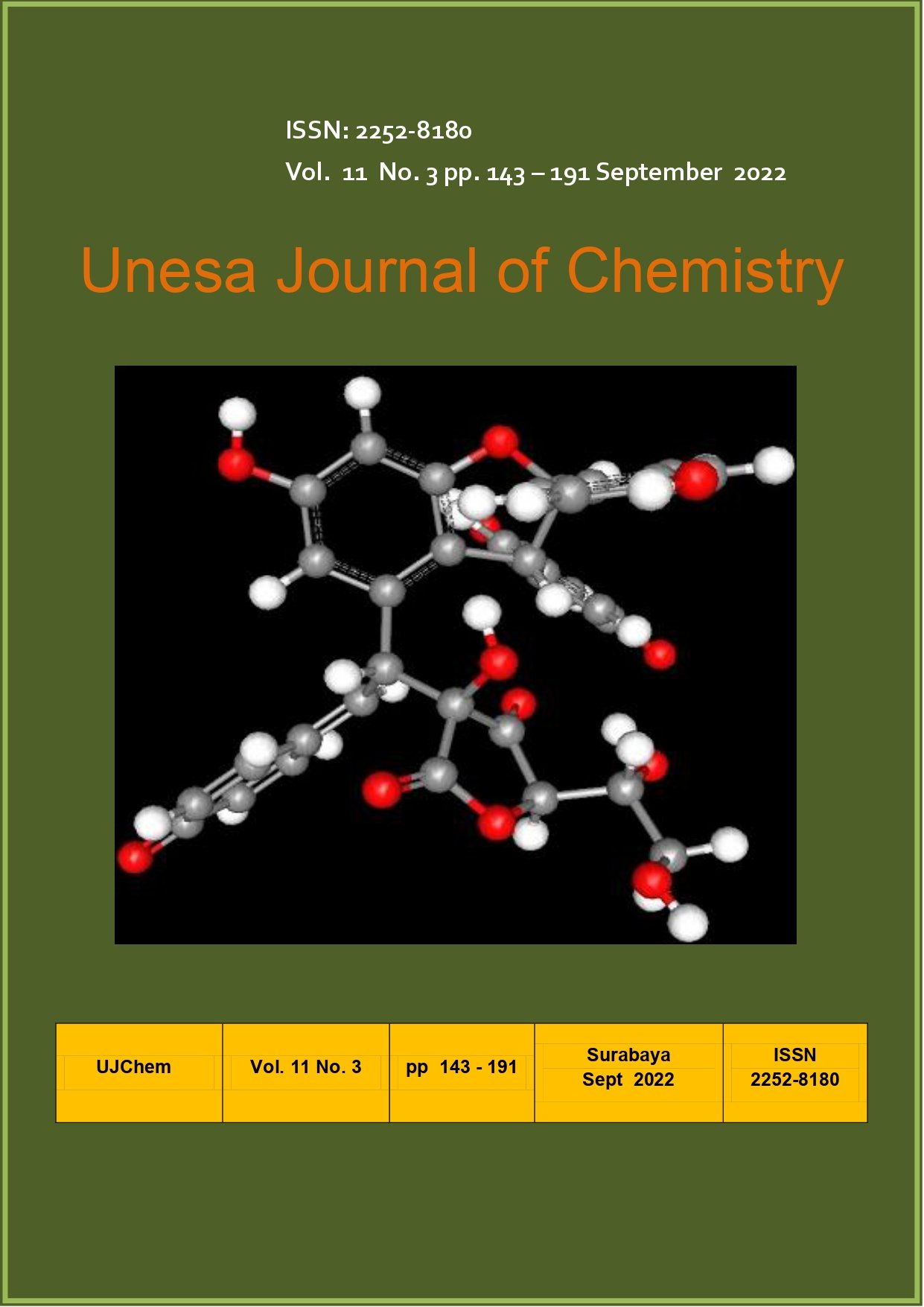Pengaruh Variasi Penimbangan Terhadap Akurasi Penentuan Bilangan Asam Pada Alkyd Resin
Main Article Content
Downloads
Article Details
References
1. Kavitha, K.S., Syed, B., Rakshith, D., Kavitha, H.U., Yashwantha, R.H.C., Harini, B.P, dan Saith, S. 2013. Plants as Green Source towards Synthesis of Nanoparticles. India: International Research Journal of Biological Sciences. Volume 2(6), pp. 66-76.
2. Babayi, H., Kolo, I., Okogun, J.I., Ijah, U. J. J. 2004. The antimicrobial Activities of Methanolic and Terminalia catappa Againt some Pathagonic Microorganisms. Nigeria: An Int. J. Niger, Soc for Experiment Bio. Volume 16(2), pp. 106-11.
3. Lembang, M.S., 2013. Sintesis Nanopartikel Emas dengan Metode Reduksi Menggunakan Bioreduktor Ekstrak Daun Ketapang (Terminalia catappa), Skripsi tidak diterbitkan, Program Studi Kimia FMIPA Universitas Hasanuddin.
4. Purnawan, Candra, Tri Martini, dan Ima Puspita Rini. 2018. Sintesis dan Karakterisasi Silika Abu Ampas Tebu Termodifikasi Arginin sebagai Adsorben Ion Logam Cu(II). Surakarta: Analytical and Environmental Chemistry Research Group. Program Studi Kimia, FMIPA, Universitas Sebelas Maret (UNS). Volume 14(2), pp. 334-339.
5. Sriyanti, S., T. Taslimah, N. Nuryono, dan N. Narsito. 2005. Sintesis Bahan Hibrida Amino-Silika dari Abu Sekam Padi Melalui Proses Sol-Gel. Jurnal Kimia Sains dan Aplikasinya. Kimia FMIPA Universitas Diponegoro, Semarang. Jurusan Kimia, FMIPA Universitas Gadjah Mada: Yogyakarta. Volume 8(1).
6. Hildayati, Triwikantoro, Faisal, H dan Sudirman. 2009. Sintesis dan Karakterisasi Bahan Komposit Karet Alam-Silika. Surabaya: Seminar Nasional Pascasarjana IX Institut Teknologi Sepuluh November (ITS), Fakultas MIPA.
7. Kirana, Rahajeng & Taufikurohmah, Titik. 2013. Sintesis dan Karakterisasi Nanopartikel Emas dengan Variasi Matriks Setil Stearil Alkohol sebagai Material Antiaging dalam Kosmetik. Surabaya: Jurusan Kimia, FMIPA UNESA. Volume 2(3), pp. 182-187.
8. Amaria, Maharani, Dina K & Sianita, Maria M. 2019. Study of Surface Plasmon Resonance of Gold nanoparticle Stabilized by L-arginine. Surabaya: Atlantis Press, Seminar Nasional Kimia. Volume 1
9. Pramudita, Intan. 2018. Fabrikasi dan Karakterisasi Fotoanoda Struktur Silicate Microsheet dengan Silica Gel dan SiO2 Hasil Ekstraksi Lumpur Sidoarjo untuk Aplikasi Dye Sensitized Solar Cells (DSSC). Surabaya: Program Magister Bidang Keahlian Rekaya Energi Terbarukan, Departmen Teknik Fisika. Institut Teknologi Sepuluh November.
10. Li, H., Hong, W., Cai, F., Tang, Q., Yan, Y., Hu, X., Zhao, B, Zang, D, & Xu, Z. 2012. Au@SiO2 nanoparticles coupling co-sensitizers for synergic efficiency enhancement of dye sensitized solar cells. Materials Chemistry, Volume 22, pp. 24734-24743.
11. Yusuf, Maulana, Dede Suhendar, Eko Prabowo Hadisantoso. 2014. Studi Karakteristik Silika Gel Hasil Sintesis dari Abu Ampas Tebu dengan Variasi Konsentrasi Asam Klorida. Bandung: Jurusan Kimia, Fakultas Sains dan Teknologi, Universitas Islam Negeri Sunan Gunung Djati. Volume 8(1), pp. 16-28.
12. Amaria, Agustini, R., & Maharani, D. K. 2010. Hibrida Aminopropil Silika Gel dari Sekam Padi sebagai Adsorben untuk Adsorpsi Ion Sianida dalam Larutan. Prosiding Seminar Nasional Kimia, Jurusan Kimia FMIPA Universitas Negeri Surabaya.
13. Gusrizal G., Santosa S.J., Kunarti E.S., Rusdiarso B. 2018. Two Highly
Stable Silver Nanoparticles: Surface Plasmon Resonance Spectra Study
of Silver Nanoparticles Capped with m-Hydroxybenzoic Acid and p-
Hydroxybenzoic Acid. Molekul. Volume 13(1), pp. 30-37.
14. Mujiyanti, D.R., Nuryoo, Kunarti, E.S. 2010. Sintesis dan karakterisasi Silika Gel dari Abu Sekam Padi yang Dimobilisasi dengan 3-(trimetoksisilil)-1-propantiol. Jurnal Sains dan Terapan Kimia. Volume 4 (2), pp. 150-167.
15. A. Ananthi, D. Geetha, and P. S. Ramesh. 2016. Preparation and Characterization of Silica Material from Rice Husk Ash-An Economically Viable Method. Chem. Mater. Res. Volume 8(6), pp. 1-7.
16. Anas Amirudin, M & Taufikurrohmah, Titik. 2013. Sintesis Dan Karakterisasi Nanopartikel Emas Menggunakan Matriks Bentonit Sebagai Material Peredam Radikal Bebas Dalam Kosmetik. Jurusan Kimia, FMIPA: Universitas Negeri Surabaya. Volume 2(1), pp. 68-75.
17. Yasser, M & Widiyanti, Setyo Erna. 2019. Pengaruh Waktu Terhadap Kestabilan Nanopartikel Emas yang Disintesis Menggunakan Ekstrak Air Daun Jati (Tectona Grandis) Termodifikasi Mercaptopropionic. Makassar: INTEK Jurnal Penelitian. Volume 6(1), pp. 43-45.
18. Suriani, Binti Sule. 2019. Sintesis Nanopartikel Emas Menggunakan Ekstrak Tunicata Pyura sp. sebagai Bioreduktur dan Uji Potensinya sebagai Antibakteri. Makassar: Skripsi Departemen kimia, FMIPA, Universitas Hassanudin.
19. Kurrey, R., Deb, M. K., Shrlvas, K., Khalkho, B. R., Nirmalkar, J., Sinha, D., Jha, S. 2019. Citrate-capped gold nanoparticle as a sensing probe for determination of cetyltrimethylammonium surfactant using FTIR spectroscopy and colorymetry. Analitycal and Bioanalytical. Springer-Verlag: Germany.
20. Alizadeh, L., Alizadeh, E., Zarebkhon, A., Ahmadi, E., Yamchi, M. R., & Salehi, R. 2020. AS1411 aptamer-functionalized chitosan-silica nanoparticles for targeted delivery of epigallocatechin gallate to the SKOV-3 ovarian cancer cell lines. Tabriz, Iran: J Nanopart Res, Springer Nature B.V. Volume 22(5), pp. 1-14.
21. Sujadi, M.S. 1983. Pe Makassar.nentuan Struktur Senyawa Organik, Ghalia Indonesia: Jakarta.
22. Fadhilah, Nur. 2018. Modifikasi Fotoanoda DSSC (Dye Sensitized Solar Cells) dengan Nanopartikel Struktur Core-shell Au@TiO2@SiO2 Berbasis SiO2 Ekstraksi Lumpur Sidoarjo. Surabaya: Departemen Fisika, Fakultas Teknologi Industri, ITS.

